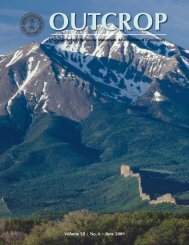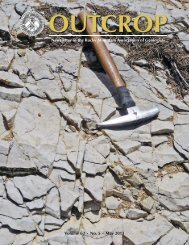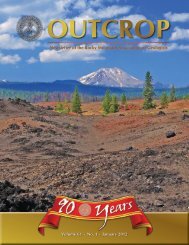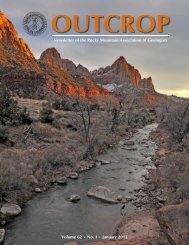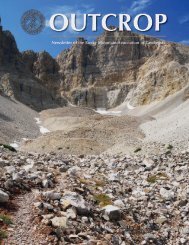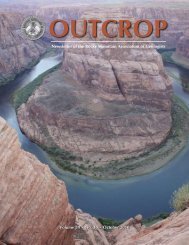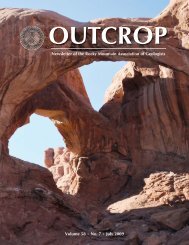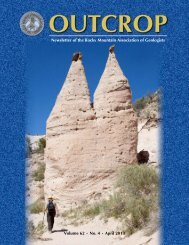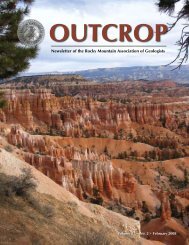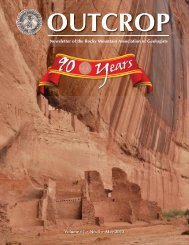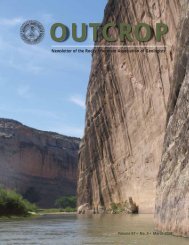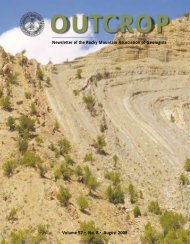February 2010 - Rocky Mountain Association of Geologists
February 2010 - Rocky Mountain Association of Geologists
February 2010 - Rocky Mountain Association of Geologists
Create successful ePaper yourself
Turn your PDF publications into a flip-book with our unique Google optimized e-Paper software.
OUTCROPThe <strong>Rocky</strong> <strong>Mountain</strong> <strong>Association</strong> <strong>of</strong> <strong>Geologists</strong>910 16th Street • Suite 1125 • Denver, CO 80202 • 303-573-8621The <strong>Rocky</strong> <strong>Mountain</strong> <strong>Association</strong> <strong>of</strong> <strong>Geologists</strong> (RMAG) is a nonpr<strong>of</strong>it organization whose purposes are to promoteinterest in geology and allied sciences and their practical application, to foster scientific research and to encouragefellowship and cooperation among its members. The Outcrop is a monthly publication <strong>of</strong> the RMAG.Co-EditorsKristine Petersonk.peterson@laramidegeo.comHolly Sellhsell@nobleenergyinc.comCatherine Campbellcatherine.campbell@encana.comDesign/ProductionDebbie Downsdebradowns@att.netFriday NoonLuncheon Reservations303-573-8621RMAG OfficeSandi Pellissier303-573-8621Fax: 303-628-0546RMAGdenver@aol.comwww.rmag.org<strong>2010</strong> Officers and Board <strong>of</strong> DirectorsPresident – Jerry Cuzellajerryc49@aol.comPresident-Elect – Ira Pasternackira.pasternack@encana.com1st Vice-President – William C. Pearsonbpearson@pearsontechnologies.com2nd Vice-President – Ronald W. Pritchettrpritchett@nobleenergyinc.conSecretary – Laura A. Maurolaura.mauro@questar.comTreasurer – Connie Knightcnknight@comcast.netTreasurer Elect – David E. Ebyepceby@aol.comCounselor (1 Year) – Edward D. Dollyrockdoc@q.comCounselor (2 Year) – John Hornejohnhorne@orionlimited.comOUTCROP ADVERTISING RATESPROFESSIONAL CARDSWill be actual size.HELPFUL HINTS – Both blackand white and color art will beaccepted. If you are submittingdigital files, please save in the PCformat. Minimum resolution forjpg, tif, pdf or eps files is 300 dpi.Simple line art and photographsprovide helpful illustration.Borders are recommendedon large copy. An advertisingagreement will be sent to you.The Outcrop is a monthly publication <strong>of</strong> the <strong>Rocky</strong> <strong>Mountain</strong> <strong>Association</strong> <strong>of</strong> <strong>Geologists</strong>910 16th Street, Suite 1125 • Denver, CO 80202OUTCROP5www.rmag.org
President’s Columnwere taken out <strong>of</strong> context and that the whole thingwas nothing more than an effort to discredit someclimatologists, and cast dispersion on sound researchsupporting the argument for anthropogenic causes forclimate change. Whether or not any improprieties werecommitted by the involved workers is yet to be determined,and I <strong>of</strong>fer no judgment on this aspect <strong>of</strong> the incident.Regardless <strong>of</strong> where one might side on the debate forthe case for anthropogenic causes for global warming,the “CliimateGate” event is cause for introspection.Certain lessons are to be learned from this whole affairand the potentially serious consequences it has on publicperception <strong>of</strong> scientists and scientific research.As geoscientists we deal with complex data sets on adaily basis which can be ambiguous and incomplete. Whenorganizing these data as maps or graphs, “data busts”(data points that just don’t fit) are a common occurrence,but when identified they are scrutinized, checked anddouble-checked to verify that they are indeed real, or theresult <strong>of</strong> some contributing error source, e.g. bad KB’s orwrong well spots. If they are real, these anomalies canbecome the basis for prospects, faults, or differences inbasement lithologies, just to name a few features withfar-reaching implications that at times are somethingto be sought-after. But what happens if the recognizedanomalies just don’t fit and can’t be reasonably explainedaway; are they to be ignored? It can be construed that incertain “CliimateGate” emails the investigators chose todisregard or manipulate data that didn’t fit the model.As geologists we’re trained to employ the “method<strong>of</strong> multiple working hypotheses” put forward by T.C.Chamberlin and first published in 1889. It forms thefundamental core for geologic research. It is an openminded,scientific approach that starts with manytentative explanations <strong>of</strong> a recognized phenomenon.As the research progresses there is the possibility thatsome explanations will be rendered incorrect, or thatnew explanations may materialize. The method promotesthoroughness, attention to detail, and can lead to lines<strong>of</strong> inquiry that might have been unnoticed. This is incontrast to the method <strong>of</strong> “ruling theory” which beginswith an explanation for a particular phenomenon andthe researcher looks for facts to confirm the answeror, the “method <strong>of</strong> the working hypothesis”—where theresearcher looks for facts to try against it. In either <strong>of</strong>these two latter methods, Chamberlin recognized a pitfallwhere there is a tendency for the researcher to developa passionate affection for the theory or hypothesis withimpartiality being abandoned. In the complex world <strong>of</strong>cutting-edge global climate modeling, where researchersare searching for answers to the earth’s ever changingand unpredictable weather patterns, the modeling processis a data driven, multifaceted, numerical simulation.In the modeling process, the model goes through arefining process and modification, eventually the dataand predictions are consistent with the model, finallyleading to acceptance. In essence the science is done.This analytical process seemingly takes the form <strong>of</strong> thesingle working hypothesis advancing into the “rulingtheory” method and dangerous territory. In this “rulingtheory,” a certain paternity eventually develops on behalf<strong>of</strong> the researcher for the theory; in contrast, the multipleworking hypothesis approach consistently drives for betteranswers. The methodology pioneered by Chamberlin 120years ago has as much application today as it was whenfirst introduced.Knowledge <strong>of</strong> geology and science in general is lackingamongst the general public, yet legislative action andpublic policy which has its basis in many earth sciencedisciplines, is being formulated that will have lasting anddirect impact on our society. The “CliimateGate” incidentseems to have shaken the public trust in science andthe way in which scientific findings are being used in thepolitical process. As geoscientists we have an obligationto educate the public and take an active role to positivelyaffect the political process. The RMAG does not makeposition statements, but the “RMAG Public Issues” pageon the RMAG website provides information on vital publicissues and corresponding links to additional information,its intent is to keep the membership up to date and activelyinvolved on public issues <strong>of</strong> interest. It can be found at:http://rmag.org/public_issues/index.asp. Check out thesite, it’s a great place to keep informed on issues that are<strong>of</strong> significance to the membership.A reprint <strong>of</strong> the 1890 text “The Method <strong>of</strong> MultipleWorking Hypotheses” by T.C. Chamberlin published inScience can be found at: www.geology.und.edu/gerla/gge487_488_499/Chamberlin1890science.pdf.»Continued from page 4Vol. 59, No. 26<strong>February</strong> <strong>2010</strong>
OUTCROP7www.rmag.org
Vol. 59, No. 28<strong>February</strong> <strong>2010</strong>
Define ReservoirParameters withConfidenceLooking to maximize opportunities in today’s volatile market?Combine the power <strong>of</strong> PETRA ® , IHS Logs, Formation Tops and our extensiveWell and Production Data to define reservoir parameters and determine newopportunities faster and more cost effectively.IHS information solutions can improve your decision-making and reduce your risk.Find out more today at www.ihs.com/reservoirsolutionsOUTCROP9www.rmag.org
Lead StoryClimateGate, Copenhagen, and theState <strong>of</strong> Climate Change in <strong>2010</strong>By Bob Cluff, RMAG 2006 Past PresidentINTRODUCTION2009 may turn out to be a turning point for the Climate Science community and proponents <strong>of</strong> anthropogenic globalwarming (AGW). Flush with the Democratic election sweep <strong>of</strong> November 2008 and high expectations for substantiveclimate change legislation in 2009, their hopes were dashed against the successive debacles <strong>of</strong> ClimateGate, theDecember Copenhagen conference, and a cap and trade bill mired in the senate with uncertain, at best, prospectsfor passage in <strong>2010</strong>. Perhaps most importantly, after a bitter campaign season promising a post-partisan, let’s all talkand find the common ground environment in Washington, the Democratic and Republican positions seem to havehardened at the extremes and there has been little or no attempt to reach across the aisle to seek solutions thateveryone can live with.Just the facts, ma’m...Let’s start this essay with a review<strong>of</strong> a few things we know about climatechange. Although climate changeproponents like to claim they havean unassailable array <strong>of</strong> facts to buildtheir case, and the skeptics reply it’sall horse, uhmmm, excrement, realityas usual lies somewhere in between.So here are a few observations I thinkeveryone might agree are real:1. Burning fossil fuels results insignificant CO 2emissions. Thebasic chemistry <strong>of</strong> hydrocarbonoxidation is well established andtwo <strong>of</strong> the reaction products areCO 2and water vapor. No surprise.2. We burn a lot <strong>of</strong> fossil fuels, andour consumption is increasing,not decreasing. As China,India, and other Third Worldeconomies expand, the demandfor electricity and transportationfuels has increased dramaticallyand fossil fuels are the cheapestand most efficient means tomeet those demands. Currentprojections by EIA are for 73%increase in non-OECD energyVol. 59, No. 2demand by 2030, most <strong>of</strong> whichwill be met by oil, natural gas,and coal (Figure 1), as comparedto a 15% total increase by theOECD countries .3. All that CO has to go some2place, and initially at least it goesstraight up into the air. Fromthere, it gets a little murky (aword you will see again in thisessay, many times…) but bestestimates are about 43% <strong>of</strong> theCO 2emissions remain in theatmosphere and the balanceis naturally sequestered by theoceans and biosphere . Themass balance between oceans,forests, soils, etc. is rather trickyto measure, but the differencebetween total CO 2emitted andCO 2remaining in the atmosphereis very clear. It helps that we selloil, gas, and coal, so we knowto a high degree <strong>of</strong> accuracyjust how much is being burnedeach year. It is probably the bestnumber in all <strong>of</strong> climate science.4. CO content <strong>of</strong> the atmosphere2has been increasing since at10least the start <strong>of</strong> the industrialrevolution, when substantialburning <strong>of</strong> coal began, andatmospheric measurementssince the late 1950s showa steady progression with aseasonal fluctuation as thebiosphere “breathes” CO 2(Figure 2) .Does it feel warm in hereto you?Is that all? Can’t we all also agreethat the planet is warming? Theclimate science community says allserious scientists agree that humanactivities are causing global warming(thereby neatly placing any scientistwho disagrees with them in the “notserious” bucket), so why haven’t Ilisted at minimum warming as the5th bullet? The answer is the recordis, and here’s that word again, murky.There are two problems, the first beingthe data itself, and the second beingexactly how do you separate naturalvariations in global temperature fromanthropogenic induced changes?Starting with the data, temperaturerecords have been kept<strong>February</strong> <strong>2010</strong>
Lead Storysince the invention <strong>of</strong> the modernthermometer in 1709, initiallyat just a few urban locales,then as the global network <strong>of</strong>weather stations expanded ata increasingly large number <strong>of</strong>surface rural and urban localities,then ships at sea, and for thelast 30 years by satellite sensorslooking down at the temperature<strong>of</strong> the upper atmosphere.Unfortunately, the nature <strong>of</strong>those temperature records havenot remained static for the last300 years; sensor technology andaccuracy has changed, the sensorlocations have been moved,the environment around thosesensors has changed as cities andtowns have grown, and even whatis being measured has changed(surface air temperature vs.upper atmospheric temperatures,for example). Another problem isclimate change is, by definition,considered to be the long termvariation in climate over largeareas, as opposed to weatherwhich we all know to be extremelyvariable on both temporal andspatial scales. So if you wantto examine climate changeover a time frame greaterthan the instrumental recordsallow, you need to correlatetemperature with some kind<strong>of</strong> “proxy” measurement thatcan be used prior to the mid-1800s. Tree rings are a favorite,taking the temperature recordback approximately 2000 years(Figure 3). All <strong>of</strong> these dataproblems result in an enormousnormalization problem, wherethe raw temperature records<strong>of</strong> various types from differentlocalities have to be “corrected”Figure 1. World marketed energy use by fuel type, 1980-2030Figure 2. Atmospheric CO 2measured at Mauna Loa sinceMarch 1958.Figure 3. Reconstructed temperature for the past 2000years compiled from 10 published sources. http://commons.wikimedia.org/wiki/File:2000_Year_Temperature_Comparison.png.to read what a common, unbiasedsensor platform would have readover the entire time series. Inmy business <strong>of</strong> evaluating welllog and core data, we like to saythat normalizing log data triesto achieve what you would getif every well was logged with thesame tool set, by the same crew,with the same protocols, underidentical borehole environmentconditions. The climate scientistsare trying to do the same thing, butwhether they have accomplishedtheir goal in an unbiased manneror not, is very much in doubt.It will be some time before weknow.ClimateGate and theBarbarians at the GateSometime on November 17th,2009, “a miracle just happened”in the words <strong>of</strong> one climateskeptic. Someone posted onan anonymous Russian FTPserver over 160 MB <strong>of</strong> “randomlyselected” emails, spreadsheets,computer codes, and notestaken from the computers at theClimate Research Unit (CRU) <strong>of</strong>the University <strong>of</strong> East Anglia in theUK. By November 20th the file hadbeen discovered by the greaterblogosphere, was immediatelydubbed “ClimateGate” by somewag (now who would have thought<strong>of</strong> that), and Google hits beganto climb exponentially. Initiallyattributed to a data theft by anunknown hacker, speculationhas since turned to an insiderrelease. The CRU is one <strong>of</strong> thefour primary sources <strong>of</strong> globaltemperature records relied uponby the IPCC and most climateContinued on page 13 »OUTCROP11www.rmag.org
Vol. 59, No. 212<strong>February</strong> <strong>2010</strong>
Lead StoryContinued from page 11science researchers to discern the long term temperaturetrends. The famous “hockey stick” graph which purportsto show a significant increase in global temperaturesince the start <strong>of</strong> the industrial revolution (the deepblue line on Figure 3) is largely a creature <strong>of</strong> the CRUtemperature dataset. The emails released largely focuson the correspondence <strong>of</strong> a few key individuals at CRU,most notably its director, with other climate researchersaround the globe .Reactions to the ClimateGate release were 100%predictable. Initially reviled by AGW supporters as a“criminal act,” with denials that any <strong>of</strong> it was evenauthentic, sites like RealClimate.org took the position <strong>of</strong>a traffic cop at an accident scene: “nothing to see herefolks, move along...”The party line became nothing inthe correspondence means anything, it’s just shop talk,there is no smoking gun, the science is solid, everybodywho understands the science agrees, and there is noreal scientific debate. Some AGW extremists went so faras to say whomever posted the data should be “tried forcrimes against humanity” if it derailed an agreementat the forthcoming Copenhagen talks. Within a fewdays, however, it became apparent (and was eventuallyadmitted) the files are genuine, do not appear to havebeen edited nor altered in any significant way, andare a true (although biased) sampling <strong>of</strong> the actualgoings on behind the scenes at CRU and other climateresearch institutes (which includes our very own NCARin Boulder).On the skeptic side, the responses ranged fromsurprisingly restrained, with the moderators <strong>of</strong>ClimateAudit and WattsUpWithThat seemingly takingthe high road while leaving the gleeful chortling <strong>of</strong> “Itold you it’s all a hoax” to their community <strong>of</strong> onlineposters; to those elements <strong>of</strong> the blogosphere thatclaim it is conclusive pro<strong>of</strong> <strong>of</strong> a vast liberal conspiracy toestablish a communist world government. Mainstreammedia including the New York Times, Associated Press,Wall Street Journal, Financial Times, Newsweek, evenour own Denver Post, covered the story with varyinglevels <strong>of</strong> enthusiasm, ranging from barely disguiseddistaste on the left (Newsweek, for example, referredto skeptics as “wingnuts”) to calls for congressionaland parliamentary investigations on the right. But evenbig science magazines, including Science and Nature,picked up the story and have run numerous articles onthe facts <strong>of</strong> and possible fallout from the release.What the ClimateGate release very clearly revealedto me is a data reduction and correction process thatis anything but transparent. CRU does not publish theraw data underlying their temperature database, citingconfidentiality restrictions with the national weatherservices that contributed to their efforts. Instead theypublish (online) a “value added” dataset that hasbeen normalized in some unspecified manner, withonly generic explanations <strong>of</strong> the process given in theliterature. Leading skeptics such as Steve McIntyre <strong>of</strong>ClimateAudit.org have fought for years to retrieve the rawtemperature datasets in an attempt to reverse out theexact corrections that were applied to the data, includingfiling numerous Freedom <strong>of</strong> Information Act requests inboth the US and the UK. The CRU emails show an activehostility towards the skeptics and their requests for totaltransparency, with pages <strong>of</strong> correspondence discussingways to thwart the FOI requests, how to hide the details <strong>of</strong>what was done to the “value added” dataset, threats todestroy the raw data before giving it up, and researcherslamenting certain aspects <strong>of</strong> their data didn’t matchup with their computer models therefore somethingContinued on page 16»OUTCROP13www.rmag.org
Vol. 59, No. 214<strong>February</strong> <strong>2010</strong>
In the Pipeline<strong>February</strong> 5, <strong>2010</strong>RMAG Luncheon. “Stratigraphic,Petrophysical, and Lithologic Analysis<strong>of</strong> the Devonian Three ForksFormation, Williston Basin, NorthDakota.” Speaker Brian Moss.<strong>February</strong> 9, <strong>2010</strong>Desk and Derrick Club Luncheon.To make reservations email saundra.thompson@anadarko.com<strong>February</strong> 12, <strong>2010</strong>DIPS Luncheon. “The ChannelStacking Matrix: A Method to RelateDeep-Water Channel StackingPattern to Reservoir Parameters.”Speaker Renaud Bouroullec. Forreservations, contact Bob Zilinskiat rezilin@aol.com or call 303-885-0615.<strong>February</strong> 16, <strong>2010</strong>DWLS Luncheon. “The Impact<strong>of</strong> Shale Layering in DeterminingStress and Anisotropy from AdvancedAcoustics and Image Data.” SpeakerShannon Higgins <strong>of</strong> Schlumberger. Forreservations http://dwls.spwla.org.<strong>February</strong> 17, <strong>2010</strong>SPE Luncheon. For more detailsvisit http://denver.spe.org<strong>February</strong> 19, <strong>2010</strong>RMAG Luncheon. “Layer-cake,Anoxia, and Other Myths-A NewLook at the Devonian-MississippianBakken Formation Reservoir,Williston Basin, North Dakota.”Speaker Sven Egenh<strong>of</strong>f.<strong>February</strong> 22-26, <strong>2010</strong>AAPG Winter EducationConference. Houston, TX.59 TH ANNUAL CONVENTION<strong>Rocky</strong> <strong>Mountain</strong> Section<strong>of</strong> theAmerican <strong>Association</strong> <strong>of</strong>Petroleum <strong>Geologists</strong>JUNE 13-15, <strong>2010</strong>DURANGO, COLORADO<strong>February</strong> 23, 2009R M S - S E P M L u n c h e o n .“Stratigraphy and DepositionalControls on the Juana Lopez <strong>of</strong> theSE Uinta Basin.” Speaker DonnaS. Anderson. For reservations, callSteve Stancel at 720-929-6536 oremail steve.stancel@anadarko.comTechnical Sessions - Oral and Poster• Shale Gas and Fractured Shale Plays <strong>of</strong> the Rockies• Tight Gas Sands and Fractured Sandstone Reservoirs• New Insights into the Paradox Basin• San Juan Basin – Mature Basin?• New Concepts and New Discoveries in the <strong>Rocky</strong> <strong>Mountain</strong> Overthrust Belt• Uranium Geology in the Rockies• CO2 Sequestration - What Have We Learned So Far?• Geothermal Energy – From Hot Springs to Produced Water• Advances in Completion Technologies & Microseismic Monitoring• Geomechanics / Deformation Styles in the Rockies• Multi-scale Observations and the Application <strong>of</strong> Remote Sensing and Lidarto <strong>Rocky</strong> <strong>Mountain</strong> Petroleum Exploration• Sedimentology and Stratigraphy <strong>of</strong> <strong>Rocky</strong> <strong>Mountain</strong> Basins• Structure <strong>of</strong> <strong>Rocky</strong> <strong>Mountain</strong> BasinsHosted By<strong>February</strong> 24, <strong>2010</strong>Oilfield Christian FellowshipLuncheon. To RSVP call Barb Burrellat 303-675-2602 or e-mail OCF-DenverChapter@pxd.comMarch 16, <strong>2010</strong>RMAG/DGS Annual 3-D SeismicSymposium. See pages 2, 19 and 36for more information.»The Four CornersGeological SocietyIf you have any events that you wouldlike to post in this column, pleasesubmit via email to Holly Sell athsell@nobleenergyinc.com or tothe RMAG <strong>of</strong>fice at rmagdenver@aol.com for consideration.OUTCROP15www.rmag.org
Lead StoryContinued from page 13needs to be done to fix the data soit does agree. A mindset <strong>of</strong> scienceas total war, it’s us vs. them, you’rewith us or you’re with the terrorists,was revealed. It was Barbarians atthe Gate, raise the drawbridge andstart boiling the pots <strong>of</strong> oil to pourdown upon them. Give up our dataand let other scientists, especially theskeptical ones, see what we’re reallydoing? Talk to these guys? Engage ina constructive dialogue? That’s notgonna’ happen on my watch...they’lljust turn it all against us.Who ya gonna’ believe, meor your own lying eyes?OK, so maybe there are someproblems with the temperature data,but climate scientists point out thereare three other global temperaturedatasets that show the same bigpicture as the CRU dataset, so evenif one is compromised surely theothers still stand. Then there are allthose retreating glaciers. Plus we’veseen pictures <strong>of</strong> those poor polarbears stranded on floating ice floes inthe arctic, they even seem to vanishwhile we’re looking (could that bePhotoshop?). And are you going totell me the pine beetles eating upthe forests <strong>of</strong> central Colorado aren’tdefinitive pro<strong>of</strong> <strong>of</strong> a warming climatealso? Just look all around you...Well, hold on a second. There arecertainly lots <strong>of</strong> lines <strong>of</strong> evidence thatsuggest the globe has warmed over the2nd half <strong>of</strong> the 20th century, withouta doubt coincidental with the increasein oil, gas and coal consumption andthe rise in atmospheric CO 2content.But as we all know, “correlationdoes not imply causation” and thecoincidence does not prove AGW ishappening, the entire temperaturerecord could just be the result <strong>of</strong>Vol. 59, No. 2natural long term variation in climate.So let’s dispense, for the moment,with the argument that the bookshave been cooked and there has notreally been any warming over the last150 years. Assuming it has warmed,by some murky and poorly quantifiedamount, was the warming natural orwas it due to fossil fuel combustion byour industrial society? Are we, in theoil and gas business, really the evilculprits they make us out to be?It turns out the answer tothis question cannot be directlydetermined, since the experimentis already running on a global scaleand we don’t have a second Earthto use as a control. So the only wayto run alternative scenarios (i.e. anEarth without an increase in CO 2fromcombustion) is through computermodeling. General climate models,or GCMs, build a representation<strong>of</strong> the Earth’s land, oceans, andatmosphere, and through a set<strong>of</strong> coupled non-linear equationsattempt to predict the distribution<strong>of</strong> temperatures in 3D through time.Like oil and gas reservoir simulators,they take a set <strong>of</strong> initial conditionsand variable inputs through time(including CO 2emissions) and tryto track where it all goes and how itimpacts the overall climate. If you canhistory match the actual temperaturerecords from the initial date to thepresent within some degree <strong>of</strong>accuracy, the model is considered tobe a reasonable representation <strong>of</strong> theactual system and running the modelforward in time is thought to be apredictive representation <strong>of</strong> what theclimate will do given future changesin the input parameters. Hence themultiple scenarios run by the IPCCto predict global warming in the 21st16century as a function <strong>of</strong> different CO 2emission rates.In our Denver Climate StudyGroup, we have a few modelers whohave been vigorous in their defense<strong>of</strong> the current round <strong>of</strong> GCMs. Aninteresting but little known revelationin this discussion group was the factthat the GCMs can replicate theobserved temperature history upuntil sometime around 1970-1975using only natural inputs: solar fluxvariations and volcanic eruptionsbeing the strongest. After the early1970s, they are no longer able totrack the temperature record withoutinserting another “forcing factor” intothe models, CO 2, and further assumecertain couplings or feedback effectsbetween CO 2and water vapor in theatmosphere. After the appropriatetweaks to their models and theequations, Voila!, everything matchesup pretty well (Figure 4). So toparaphrase Groucho Marx: who areyou gonna believe, my computermodels or your own lying eyes? It hasto be AGW because the computermodels say it is. It doesn’t matter thatthe climate on Earth is and has beennaturally variable, or that we’re in aninterglacial period; we understandwhat drives climate and the computermodels require the extra kick <strong>of</strong> CO 2to get the history match.Whether you believe any <strong>of</strong> this orthink it’s all a bunch <strong>of</strong> hooey dependsa lot on your trust in computer models,how you feel about the history matchpiece <strong>of</strong> their efforts (pay attention tothe prior discussion re. normalization<strong>of</strong> the raw temperature records), andthe sensitivity <strong>of</strong> non-linear systems tosmall changes in the initial conditions.It also says something about what you<strong>February</strong> <strong>2010</strong>Continued on page 22»
Think outside the computer screen.Choose from over 50 exciting field seminars, short courses and online programs all designed with thegoal <strong>of</strong> helping you explore and better understand the science <strong>of</strong> this industry. Please see the AAPG websitefor complete descriptions and registration information. Below are the highlights <strong>of</strong> courses coming up verysoon. Make your plans now before seats get filled!Short Courses:MARCH22-24APRIL10-11Petroleum Exploration in Fold& Thrust Belts, Austin, TXAssessment <strong>of</strong> UnconventionalShale Resources UsingGeochemistry, New Orleans, LA(with AAPG Annual Meeting)APRIL9-11APRIL27-30Practical Salt Tectonics, New Orleans, LA(with AAPG Annual Meeting)Basic Well Log Analysis,Austin, TXOnline Courses:LAUNCH DATEFEB 1Solar Energy Basics –A Renewable EnergyCertificate CourseLAUNCH DATEAPR 1Biomass Energy Basics –A Renewable EnergyCertificate CourseE-Symposium Series:JAN28Horizontal Drillingfor <strong>Geologists</strong>FEB11Ultra Deepwater:Structure andMethane HydratesFEB25Creativity inExplorationField Seminars:Last Chance:APRIL1-2Field Safety Course for Field TripLeaders, April 1-2, Houston, TXFEB22-26Winter Education Conference,Houston, TXMore Science Than You Can Shake A Pick At.For more information on any AAPG Education programs, call 918-560-2650or toll-free 1-888-338-3387, or visit www.aapg.org/education.OUTCROP17www.rmag.org
Gerry Forney Donation to Wyoming EORILongtime geologist GerryForney has donated a decade’sworth <strong>of</strong> data on oil and gaswells in the Powder River Basinto the Enhanced Oil RecoveryInstitute (EORI) at the University<strong>of</strong> Wyoming, a gift that will furtherEORI’s mission to help Wyomingoil companies extract oil left inthe ground after conventionalproduction.The database containsinformation on about 7,000oil and gas wells, includinglocation, formation tops, drillstemtests, cores, perforations andinitial potentials. More than 80oil companies have used thedatabase to explore for newwells, or “wildcat” wells.“We have the ultimatedatabase for anything anyonewants to know about Wyoming oilfields,” says EORIDirector Jim Steidtmann.Forney, whose company, Minnelusa ExplorationDatabase, was active from 1983-1992, establishedthe database for his own use with early spreadsheettechnology and then <strong>of</strong>fered it as a service to oilfieldexploration companies.Now, Steidtmann says the database will be aninvaluable source <strong>of</strong> informationfor enhanced oil recovery, or theprocess <strong>of</strong> rescuing oil left in theground following conventionalextraction techniques.“No one was very interestedin the database until companiess t a r te d d o i n g c o mpute rmapping,” says Forney, who nowtravels from his Denver <strong>of</strong>fice toUW once a month to integrateinformation from his databaseinto the EORI database. “Oncethey did computer mapping, theneverybody wanted computerreadyinformation.” It grewfrom a simple spreadsheet toa database complete with dataanalysis and validation.”Forney’s gift was inspiredby the Anaconda collection<strong>of</strong> economic geology at UW’sAmerican Heritage Center. The Anaconda MiningCompany collected mining data around the world formore than 90 years before donating it to the universityin 1987. Forney read about the gift and wanted to makea similar gift.“I am very pleased that my data has found a goodhome at the University <strong>of</strong> Wyoming,” he says.»Vol. 59, No. 218<strong>February</strong> <strong>2010</strong>
“Uplifting the Rockies:” 3D Symposium Set for March 16 th , <strong>2010</strong>The 16th annual 3D Seismic Symposium, jointlysponsored by the <strong>Rocky</strong> <strong>Mountain</strong> <strong>Association</strong> <strong>of</strong><strong>Geologists</strong> and the Denver Geophysical Society, will beheld on Tuesday, March 16th, <strong>2010</strong> at the Marriott CityCenter in Denver, Colorado. This year’s theme is “Upliftingthe Rockies.” Co-chairs are Randy Ray, Julie Shemeta,and David Scolman. Abstracts have been submitted tothe meeting committee, and a very strong selection <strong>of</strong>presentations is currently under review.Bob Peebler, CEO <strong>of</strong> ION is slated as a special guestspeaker. Bob will discuss the Mega-Trends in our industry,specifically the 1) Rapid Innovation and diffusion <strong>of</strong>geophysical ideas across the globe, and 2) IntegratedPartnerships <strong>of</strong> pr<strong>of</strong>essionals across country boundariessince today people across the globe can collaborateon new ideas within companies and form partnershipswith other companies around the world. He will detailthese concepts with examples from within ION, and alsodiscuss the future <strong>of</strong> geophysics as he sees it growingaround the globe.One session <strong>of</strong> this year’s Symposium will involvea full slate <strong>of</strong> the latest developments in shale playsacross the US. This session will kick <strong>of</strong>f with a Shale GasReservoir Comparison, an integrated review <strong>of</strong> publisheddata, type logs, seismic and microseismic data, and fiveyears <strong>of</strong> study to gain an understanding <strong>of</strong> the variabilityin North American shale plays. The Eagle Ford Shale<strong>of</strong> South Texas, one <strong>of</strong> the more exciting shale playstoday, will be presented, showing the geologic history<strong>of</strong> the Eagle Ford, followed by a geophysical reviewdemonstrating how a properly acquired and processed3D provides a picture <strong>of</strong> ultimate reservoir quality,comparing seismic analysis techniques with geologicalinterpretation. A recently acquired Williston Basin 3D willbe presented from the perspective <strong>of</strong> both the operatorand the processor, comparing time vs. depth imagingexamples, and a detailed discussion <strong>of</strong> overburdenheterogeneity in terms <strong>of</strong> Vp and TI parameters and theimpact on PSDM results. 3D seismic data’s impact onthe Marcellus and the Woodford shale plays are also onthe agenda.A second group <strong>of</strong> talks will include an excitingvariety <strong>of</strong> hot topics from across the Rockies. 3D seismicis effectively utilized to image a structurally complex,productive wrench fault system in Montana. A fracturedTensleep field in Wyoming will be analyzed using aContinuous Fracture Modeling workflow that allows theinterpreter to characterize the fractured reservoir ina manner suitable for reservoir simulation. A detailedcomparison <strong>of</strong> well log analysis, core descriptions, and3D seismic in Utah’s Uinta Basin allows the geoscientiststhe ability to delineate future drilling targets inchannel complexes. In Colorado, unique and innovativeapproaches to 3D seismic acquisition break previouslyexistingbarriers and allow the geophysical industry moreflexibility in acquiring data.Mark your calendar for March 16 th , and makeplans to join us for what will no doubt be a great day <strong>of</strong>presentations on the very latest trends and conceptsour industry has to <strong>of</strong>fer. For more information, contactCo-Chair Julie Shemeta at julie.shemeta@gmail.com.»OUTCROP19www.rmag.org
Luncheon Programs – <strong>February</strong> 5 thStratigraphic, Petrophysical, and Lithologic Analysis <strong>of</strong> the Devonian ThreeForks Formation, Williston Basin, North DakotaBy Brian Moss, Continental Resources, Inc., <strong>February</strong> 5 thThe lower units <strong>of</strong> theThree Forks Formation(THRFKS D-F) werefound to be comprisedprimarily <strong>of</strong> dolomite,anhydrite, and oxicshale that representdeposition in arestricted sabkha-likeenvironment.This study sought to improve the understanding <strong>of</strong> the distribution andhydrocarbon producing reservoir properties <strong>of</strong> the Devonian Three Forks Formationwithin the Williston Basin <strong>of</strong> North Dakota by means <strong>of</strong> integrated stratigraphic,petrophysical, and lithologic analyses. Wireline logs and core data from NorthDakota were the primary sources <strong>of</strong> data used in the study. The study wasdesigned to meet four primary objectives: (1) subdivide the Three Forks Formationinto stratigraphic subunits, (2) describe each subunit on the basis <strong>of</strong> lithologyand petrophysical properties to establish reservoir properties, (3) delineate thedistribution <strong>of</strong> the subunits throughout the Williston Basin in North Dakota, and(4) define the lithologic and petrophysical parameters with provide the basis forthe success <strong>of</strong> the Three Forks Formation as an oil and gas producing reservoir. Inthe study, the Three Forks Formation was subdivided into six clearly defined, widelymappable subunits based on the foundation provided by Christopher (1963) inwhich subunits were defined based on argillaceous content. This work subdividedthe formation based on less-radioactive and more-radioactive subunits namedTHRFKS A, THRFKS B, THRFKS C, THRFKS D, THRFKS E, and THRFKS F. The lowerunits <strong>of</strong> the Three Forks Formation (THRFKS D-F) were found to be comprisedprimarily <strong>of</strong> dolomite, anhydrite, and oxic shale that represent deposition in arestricted sabkha-like environment. The upper units <strong>of</strong> the Three Forks Formation(THRFKS A and B) are primarily dolomite and green shale with minimal amounts<strong>of</strong> anhydrite indicating deposition in slightly deeper water, possibly in the intertidalzone. THRFKS C marks the transition from a highly restricted basin to a deeper,more open environment. THRFKS A is the most prospective hydrocarbon-producingLuncheon Reservations And InformationLuncheons will be held at the Marriott City Center at California and 17th St. Please check theevent listing in the lobby for the room. People gather at 11:30 a.m., lunch is served at 12:00noon, and the speaker presentation begins at about 12:20 p.m. The price <strong>of</strong> the luncheon is$30.00. Checks should be made payable to RMAG. No reservation is required for the talk onlyand the cost is $5.00. Please make your reservation prior to 10:30 a.m. on the Wednesdaybefore the luncheon. Please Note: If you make a reservation and do not attend the luncheon,you will be billed for the luncheon. Cancellations are not guaranteed after 10:30 a.m. theWednesday before the talk. You may send someone in your stead.Your attendance iswelcomed and encouraged.Bring a guest or new member!Call 303-573-8621Vol. 59, No. 220<strong>February</strong> <strong>2010</strong>
Luncheon Programinterval <strong>of</strong> the Three Forks Formation due to its proximity to the Lower Bakken Shale.Some porosity (average 6.5%) is present in the THRFKS A, but permeability is low(average 0.054mD). Permeability and the resultant production from the Three ForksFormation are attributed to tectonic fracturing and fracturing caused by oil expulsionand migration from the over-pressured Lower Bakken Shale.SLayer-cake, Anoxia, and Other Myths – A New Look at the Devonian-Mississippian Bakken Formation Reservoir, Williston Basin, North DakotaBy Sven Egenh<strong>of</strong>f, Department <strong>of</strong> Geosciences, Colorado State University, <strong>February</strong> 19 thThe Upper Devonian-Mississippian Bakken Formation in the Williston Basin is one<strong>of</strong> the most prolific onshore petroleum systems in the continental U.S. It consists <strong>of</strong> amiddle mixed carbonate-siliciclastic member, sand¬wiched between the two organicrichunits, the Lower and Upper Bakken shales.Sedimentological models for the Bakken tend to show a layer-cake stratigraphyenvisioning each <strong>of</strong> the lithostratigraphic units to represent a single time slice inthe evolution <strong>of</strong> this basin. However, this concept violates basic rules <strong>of</strong> sedimentdeposition. As an example, the recent Black Sea is known to deposit sediments inContinued on page 25 »OUTCROP21www.rmag.org
Lead StoryContinued from page 16consider to be a “good match” andthe time frame under consideration.The skeptic community has beenvery quick to point out that evidencefor global warming over the last 10years, post-1998 in particular, hasbeen anything but clear cut and infact temperatures have been flator even cooled slightly when all theGCMs predicted a steady increase(Figure 5). The modelers reply that10 years is too short a time frameto consider, that’s weather, andnatural variability will always besuperimposed even if the long termtrend is up, up, up. So you may naivelyask: what’s the right timeframe? Well,somebody seems to have decided30 years is about right, and lo andbehold they see a distinct decoupling<strong>of</strong> temperature due to naturalinfluences alone around 1970.Sounds a bit like Goldilocks and the3 Bears, doesn’t it?Copenhagen bluesIn December, it was all supposedto come together in a hand-holdingKumbaya moment for the climatechange community with their victoriousagreement to reduce (nay, eliminate)CO 2emissions to a level that wouldhold the 21st Century temperaturerise to 2 degrees Celsius . The totalamount <strong>of</strong> permissible CO 2emissionswould be dictated by the GCMs, whilethe distribution <strong>of</strong> CO 2reductionsbetween nations and industrieswould be left to the messiness <strong>of</strong> themarketplace through some kind <strong>of</strong>carbon tax or trading system similarto that established by the KyotoProtocol. Presumably there wouldalso be a net transfer <strong>of</strong> money fromthe industrially developed nations tothe Third World as compensation fortheir 150 years <strong>of</strong> prior CO 2emissionsVol. 59, No. 2and the load already deposited inthe atmosphere. The murkiness <strong>of</strong>the entire process comes in becauseCO 2emissions in the developed worldhave largely stabilized, in line withenergy demand growth, whereas theyare rapidly growing in the Third Worldas countries industrialize.Not surprisingly, an agreementfailed to materialize. China, India,and the other rapidly growing ThirdWorld economies are unwilling toconstrain their growth prospects bytrading cheap and abundant fossilfuel energy for the uncertain promise<strong>of</strong> a green, alternative energy future.Wind and solar remain unpalatablechoices for transportation needs,and are too expensive for electricpower generation; bi<strong>of</strong>uels redirectagricultural land and resources fromgrowing food to fuel, while many peopleare still hungry. The green parties,although long on street theatre andpolitical sway in Europe, seem unableto grasp the complexity <strong>of</strong> energy usein the modern world. Much like thec<strong>of</strong>fee house intellectual Bolshevikswho, having no actual life experiencewith money, thought money wasunnecessary and after seizing powerattempted to abolish it in SovietRussia; the green parties have no realconcept <strong>of</strong> the importance <strong>of</strong> fossilenergy for today’s civilization andthink it should simply be banned tosave the planet from global warming.The industrial economies <strong>of</strong> theUS, Europe, and east Asia all find itpolitically unacceptable to agree todeep emissions cuts at enormousexpense when the developing worldwill continue to grow their emissions(at best at a reduced rate), effectivelyyielding future economic growth tothe Third World. And because the UN22process requires unanimous adoptionby all 193 members, a few nations thatpreferred to use the forum for politicaltheatre (Venezuela and Boliva, inparticular) were able to doom anyserious efforts at compromise.Burn her! She’s a witch!So here we are at the start <strong>of</strong> anew decade, with zero progress inreduction <strong>of</strong> CO 2emissions since theKyoto conference <strong>of</strong> 1997. Despite anactive market for CO 2emission creditsin Europe, the cost <strong>of</strong> those tradableunits are far below the actual cost <strong>of</strong>mitigation and dropped even furtherin the wake <strong>of</strong> the Copenhagencollapse. A recent analysis <strong>of</strong> hybridvehicle economics reviewed in theOil and Gas Journal estimated hybridSUV’s will not be competitive withequivalent gasoline powered modelsunless oil hits $230/bbl, illustratinghow wide the gap is between alow carbon future and our currenttransportation economics. I’ve seensimilar 2X-4X estimates for increasesin the cost <strong>of</strong> retail electricity if zero-CO 2emission strategies are enforced,either through carbon capture andsequestration or via conversion towind and solar on a massive scale.Consumers throughout the world aregoing to look at the bill to convertto a low carbon, green economy,and they are going to revolt. It won’thappen. They’ll pick up the pitchforks and torches first and go afterwhomever seems to be the guiltyparty. Politicians will not want to getin front <strong>of</strong> that crowd.At some point, climate realistsare going to take over the discussionfrom the alarmists. Some kind <strong>of</strong>dialogue should emerge, probablyalong parallel lines <strong>of</strong> 1) reducingCO 2emissions ins<strong>of</strong>ar as possible<strong>February</strong> <strong>2010</strong>
Lead Storywithin the limits <strong>of</strong> what iseconomically justifiable; 2)limited carbon capture andsequestration, although Ipersonally suspect this willnever be economic unlessthere is a huge technicalbreakthrough on the captureside; and 3) adaptation to achanging world. Change hasbeen a constant throughoutgeologic time and humanhistory, and we have no reasonto expect climate to remainconstant now in some kind<strong>of</strong> Goldilocks, “it’s just right”moment. On the other hand,if we are impacting the longterm climate through CO 2emissions, then it would alsobe prudent to back <strong>of</strong>f to notpush things too far.Within the climate sciencecommunity, we’re starting tosee a little bit <strong>of</strong> hand wringingand some consideration thatmaybe the path they are onis not the optimum way to goabout things. The ClimateGateemails have caused someto pause and reflect on thepeer review process, on theirinteraction with the skepticscommunity, and the role <strong>of</strong> astrong adversary in keepingscience honest. It is alsoapparent that much greaterdata transparency will bedemanded, especially whereFigure 4. Global temperature predictions from models that use onlynaturally variable inputs, principally volcanic eruptions and changesin solar flux, vs. those that also include greenhouse gases and sulfateaerosols. Prior to the 1960s natural forcings explain all observedtemperature variation. Sometime in the mid-1960s the trends begin todiverge slightly, but it is not until the late 1970s that models run usingnatural forcings only fail to follow the observed increase in temperaturewithin the range <strong>of</strong> model uncertainties (from Meehl, NCAR, http://www.ucar.edu/news/features/climatechange/index.jsp). No comment on theaccuracy <strong>of</strong> the black line representing observed temperatures.Figure 5. Global temperature since 1975, showing no statisticallysignificant increase since 1999. Note Figure 4 stops near the peak <strong>of</strong>this graph in 1999.public funding is involved. Whether an actualdialogue will be established remains very much indoubt; within our own Denver Climate Study Groupwe’ve been able to hold together a civil discussion,but we’re still worlds apartand few opinions have beenaltered over the past 2 years.For those <strong>of</strong> us in the oiland gas business, we willcontinue to be painted as theevildoers. Get over it. For whatit’s worth, here’s somethingto consider that might helpyou feel like the greenestperson out there: the bestcase scenarios for carboncapture and sequestration atlarge electric power generationfacilities project 90% emissionreductions by 2050 for hugeincreases in electric powercosts. Today, without inventinganything, just switching fromcoal fired to natural gas firedburners gets you a 50-60%reduction in emissions on akWH basis, and changing toa combined cycle generationfacility gets you most <strong>of</strong> therest <strong>of</strong> the way to the 90%target. Combine that with a40-year headstart, since wecan do it today, and we’reunbeatable. So if you arein the gas exploration andproduction business as somany <strong>of</strong> us are today, feelgood when you go home atnight that you’re doing yourpart to reduce the CO 2load inthe world!»All <strong>of</strong> the opinions expressed in this essay are solely those <strong>of</strong> the author and do not reflect the position <strong>of</strong> RMAG or any other organization. I haveattempted to refrain from citing specific individuals throughout, but if I have <strong>of</strong>fended anyone, please accept my apologies.http://www.eia.doe.gov/oiaf/ieo/highlights.html site visited 3 Jan <strong>2010</strong>LeQuere et al, 2009, Nature Geoscience v 2, n 12, p 832http://www.esrl.noaa.gov/gmd/ccgg/trends/co2_data_mlo.html site visited 3 Jan 2009The CRU emails and other files obtained and generally referred to as “ClimateGate” are searchable online at http://www.climate-gate.org/ andhave been quoted extensively in the press and in online blogs.http://tech.groups.yahoo.com/group/DenverClimateStudygroup/OUTCROP23www.rmag.org
The 2009Paradox BasinGuidebookis ready for purchase,so please sign up forthis great publicationthat has over 800 pageswith amazing figuresand new developmentsin petroleum systemsand basin analysis.CALL THERMAG OFFICE at303.573.8621for moreinformation.Petrolific Consulting ServicesPeter DebenhamWellsite Geologist “When pigs fly”P.O. Box 350 • Drake, Colorado 80515720.220.4860 • petrolific@gmail.comWALT KING, PETROLEUM ENGINEERLICENSED - COLORADO, WYOMINGRESERVES PROPERTY EVALUATIONFIELD STUDIESOFFICE - (303) 893-1770HOME - (303) 773-1080410 17TH STREET, SUITE 1170 CELL - (720) 219-7897DENVER, COLORADO 80202-4474 WAKPE@INDRA.COMVol. 59, No. 224<strong>February</strong> <strong>2010</strong>
Luncheon ProgramContinued from page 21Another conceptthat blurs ourunderstanding<strong>of</strong> the Bakkendepositionalsystem is thenotion thatthe two shaleunits representsedimentation inan anoxic tranquilsetting.a dysoxic to anoxic environment in deep water, however, its margin is still characterizedby high-energy beaches with shoreface and foreshore deposits. It should therefore beexpected that the two Bakken black shales are the basinward continuation <strong>of</strong> a nearshore,oxic and high-energy environment. Therefore, likely a part <strong>of</strong> the Lodgepole Formationrepresents the shallow-water equivalent to the basinal Bakken Shales.The concept <strong>of</strong> sediments forming time-equivalent layers <strong>of</strong> similar facies throughoutlarger parts <strong>of</strong> the basin has also been applied to the internal architecture <strong>of</strong> the carbonatesiliciclasticMiddle Bakken Member. This lead to the idea that the eastern flank <strong>of</strong> thebasin was characterized by widespread sheets <strong>of</strong> oolitic sandstones with laterally varyingthickness - which is likely not the case. In contrast, it seems much more likely that ona large low-inclined margin sediment wedges stepped down the ramp pr<strong>of</strong>ile followinglowering <strong>of</strong> base level. In order to detect such parasequences, the Bakken Formation facieswas examined in great detail, identifying eleven distinct depositional facies, arranged int<strong>of</strong>our parasequences. The lower two <strong>of</strong> these parasequences show an overall progradation<strong>of</strong> the sedimentary system, culminating in the deposition <strong>of</strong> sandstones and ooids. Theupper two retrograding parasequences indicates a deepening <strong>of</strong> the basin setting thestage for the deposition <strong>of</strong> the upper member black shales. The parasequences allow fordrawing time-lines through the Middle Bakken Member. Using this concept the sandstoneswith oolites can be shown to occur in different stratigraphic levels and therefore do notrepresent time-equivalent deposits.Another concept that blurs our understanding <strong>of</strong> the Bakken depositional system isthe notion that the two shale units represent sedimentation in an anoxic tranquil setting.Detailed facies analysis <strong>of</strong> the upper shale member <strong>of</strong> the Bakken Formation, however,shows three distinct facies belts, with at least two <strong>of</strong> them characterized by vertical and/or horizontal bioturbation, and storm influence on deposition. Thus, it is unlikely that theupper Bakken Shale was deposited in a continuously anoxic environment; in contrastit seems to be more likely to assume dysoxic to oxic conditions during Bakken Shalesedimentation. These findings have also implications on the assumed depth <strong>of</strong> the basin:the upper shale member <strong>of</strong> the Bakken Formation represents a highstand unit, sandwichedbetween the overlying Mississippian Lodgepole Formation and the middle BakkenMember. Although the basin center was at its greatest depth during periods <strong>of</strong> elevatedsea-level, storms episodically influenced Bakken sedimentation, which indicates that thisbasin was a relativelys h a l l o w t r o u g h w i t hmaximum depth onlyslightly below storm wavebase, perhaps
Missing well data?- Well Log Data AvailableLet TGS complete the picture.TGS adds hundreds <strong>of</strong> complete LAS everyday tothe world’s largest LAS library, with well logs in 29countries.And since you asked for it, we now have nationwideUS Production Data.Our well data is online, available immediately, witha team <strong>of</strong> dedicated customer support specialiststhere for you.If your own proprietary well files are piling up, ournew team <strong>of</strong> well data solutions experts can build acustom solution suited to your needs.For more information, call 888 LOG-LINE or email usat WellData@tgsnopec.comNORWAY +47 66 76 99 00 | USA +1 713 860 2100 | UK +44 (0) 1234 272122 | AUSTRALIA +61 8 9480 0000© TGS-NOPEC Geophysical Company. All rights reserved.Vol. 59, No. 226<strong>February</strong> <strong>2010</strong>
Welcome to New Members...Criag HarranCraig is a Geologist at Devon Energy located inOklahoma City, OK.Richard KilbyRichard is the Staff Geologist for Murphy OilCorporation located in Houston, TX.Ronald StillwellRonald is the Senior Staff Geologist for EncoreAcquisition located in Fort Worth, TX.Sharon MilitoSharon currently resides in Colorado Springs, CO.Melanie PetersonMelanie is works at Noble Energy located in Denver,CO.Have an article or photo for theOutcrop?The editors want to hear from you! We are looking forarticles and photos for the Outcrop. What content wouldyou like to see? Please submit your ideas or articles andphotos to:Sandi Pellissier, RMAGDENVER@aol.comKristine Peterson, k.peterson@laramidegeo.comCat Campbell, catherine.campbell@encana.comHolly Sell, HSell@nobleenergyinc.comPlease be sure to include a phone number andmake sure our emails are white listed. We have had afew submissions that we wished to run but we could notreach the submitters by email and had no other contactinformation.»Ginny GentGinny is a Geological Tech Lead for EOG Resourceslocated in Denver, CO.Welcome to New Students...Erich HeydweillerEric is a Graduate Student at the Colorado School <strong>of</strong>Mines located in Golden, CO.»30 Years Oil and GasIndustry ExperienceCPG 8653Anne D. Weber, Managing AttorneyAcquisitions • Divestitures • Industry Agreements1580 Lincoln St., Suite 700 Denver, CO 80203Phone: 303-893-2004 aweber@weberlawfirm.usOUTCROP27www.rmag.org
CONTINUOUS DEVELOPMENTConquest Seismic Services has over the pastfew years worked closely with variousmanufacturers to combine industry standardand emerging technologies in order to increaseboth the seismic spatial resolution and fieldproductivity. The former is aimed at improvingthe seismic image, the latter at controlling thecost <strong>of</strong> the improvements.By combining ARAM's flexibilities withConquest’s field experience a cost effective,high resolution, 3-component product can beprovided.ARAM ARIES-MCFull Wave 3-Component Seismic Recording• 3-C High Spurious-free Frequency• 24 bits digital acquisition• 1/4ms, 1/2ms, 1ms, 2ms, 4ms sample rates• Reduced power consumption• Advanced QC & Maintenance tools• Vibroseis or impulsive recording• -40C to +70C operationsQUALITY CONTROL FEATURESThe acquisition <strong>of</strong> seismic data from thousands<strong>of</strong> channels requires the ability to ensure thequality <strong>of</strong> the data using:• Intuitive graphic display <strong>of</strong> quality attributes• Unique Azimuth-Corrected Orientation Q.C.• GPS Integration• System generated observer's notesBENEFITSARAM ARIES-MC is designed to:• Reduce the environmental footprint• Reduce crew size• Reduce mobilization costs• Reduce maintenance costs• Improve productivity• Improve Health and Safety• Increase spatial samplingARIES-MC 3C Sensor10,884 Channel AcquisitionColoradoConquest Seismic Services, Inc.Suite 100 - 6430 S. Fiddler’s Green CircleGreenwood Village, Co. 80111Phone: (303) 287-5700Fax: (303) 287-6688Vol. 59, No. 228www.conquestseismic.comNew YorkConquest Seismic Services, Inc.504 IST Center,Horseheads, NY 14845Phone: (607) 562-2220Fax: (607) 562-2227<strong>February</strong> <strong>2010</strong>
<strong>Rocky</strong> <strong>Mountain</strong> Geoscience & Technology ConferenceTopicsJoint Energy Epicenter Event sponsored by:<strong>Rocky</strong> <strong>Mountain</strong> <strong>Association</strong> <strong>of</strong> <strong>Geologists</strong> and The Colorado Oil & Gas <strong>Association</strong>CALL FOR PAPERSDeadline: <strong>February</strong> 15th, <strong>2010</strong>See Call for Papers Instructions: www.energyepicenter.orgn Rebalancing the Portfolion Shale Oil Reservoirsn New look: Oil Plays <strong>of</strong> the Rockiesn Tight Gas Reservoirsn Shale Gas Plays <strong>of</strong> the Rockiesn Enhanced O&G Recovery Techniquesn Unconventional ReservoirsFor Conference Updates: www.energyepicenter.orgExpected attendance for <strong>2010</strong> - more than 2,000OUTCROP29www.rmag.org
Custom Accounting Solutions, LLC720‐231‐8941Bookkeeping ServicesFull Financial PrepFull Payroll ServicesAR, AP, GL, Payroll Tax, Sales Tax, Etc.Outsourcing Bookkeeping is less expensive,efficient and allows you to focus on your Business.We can do all your books or just a portion <strong>of</strong> your books.Vol. 59, No. 230<strong>February</strong> <strong>2010</strong>
RMAG December Joint Board <strong>of</strong> Directors MeetingBy Laura Mauro, Secretary (Laura.Mauro@Questar.com)The 2009 and <strong>2010</strong> Board <strong>of</strong> Directors met onDecember 11 th for the annual joint meeting with incoming<strong>2010</strong> Board members. This was a collaborative meetingwhere the current board handed over the reigns to thenew board. New Board Members were engaged withupdates on voting, finance, <strong>of</strong>fice report, publications,continuing education events, and formation <strong>of</strong> newcommittees. As a person new to the Board’s innerworkings, this was a very enlightening meeting, and itwas apparent how much dedication and hard work your2009 Board <strong>of</strong> Directors and <strong>of</strong>fice staff put in to makethis past year a success. As a member <strong>of</strong> RMAG, I wouldlike to thank the 2009 Board <strong>of</strong> Directors for all theircontributions and service.The meeting started with great news on the success<strong>of</strong> our Ballot Committee this year. Voter participationincreased significantly, partly due to envelopes mailedwith the ballot. The committee reported approximately30% participation from the membership and hopes toincrease participation in the years to come. Okay, so30% is pretty good, but geoscience pr<strong>of</strong>essionals arenotoriously active and engaging people. We should beable to do better than 30%, so don’t forget to vote in thenext election!Our 2009 Treasurer, Paul Ozanich, reported that our2009 income was <strong>of</strong>f budget by 4.9% and would havebeen <strong>of</strong>f by 17.4% if we hadn’t received cash infusionsfrom AAPG and our investment fund. The Board and<strong>of</strong>fice staff did an excellent job in keeping expenses lowthis year and came in 6.2% under budget.Our Continuing Education Committee has beenworking very hard to plan several events for <strong>2010</strong>. Itshould be a great year with opportunities for pr<strong>of</strong>essionaldevelopment through short courses, the spring 3-DSeismic Symposium, and the Fall Symposium. We arekicking the year <strong>of</strong>f right with a great short course onpaleogeographic and paleotectonic maps by Dr. RonBlakey. It will be great to not only meet the man behindall those beautiful maps that are used by pr<strong>of</strong>essionalsaround the world, but also to learn how to generate amap <strong>of</strong> your own!Our Publications Committee will be working hardthis year on a <strong>2010</strong> Guidebook on resource plays aswell as continuing to provide quality publications throughthe Outcrop and The <strong>Mountain</strong> Geologist. The 2009Paradox Basin Guidebook is ready for purchase, soplease sign up for this great publication that has over800 pages with amazing figures and new developmentsin petroleum systems and basin analysis. A publicationon structural applications to <strong>Rocky</strong> <strong>Mountain</strong> hydrocarbonaccumulations is in the works for 2011.The January BOD meeting was held on the 20 th at4:00 p.m. in the University Building conference room onthe third floor. The <strong>February</strong> meeting will be held on the17 th at 4:00 p.m. in the University Building conferenceroom on the third floor.»OUTCROP31www.rmag.org
PTTC WorkshopsFluvial StratigraphyThursday and Friday, January 14-15, <strong>2010</strong>Colorado School <strong>of</strong> Mines, Ben Parker Student Center, Ballroom CFee: $350; Includes: refreshments, workbook, and PDH certificateInstructor: John Holbrook (University <strong>of</strong> Texas, Arlington)Applied Hydrodynamics in Petroleum Exploration & ProductionWednesday and Thursday, January 20-21, <strong>2010</strong>Colorado School <strong>of</strong> Mines; Fee: $350Includes: refreshments, workbook, and PDH certificateInstructor: Eric Dahlberg, ECD Geological Specialists (1979), Saskatchewan Petroleum Ventures LTD.Petra BasicsMonday, <strong>February</strong> 1, <strong>2010</strong>, 8:30 am – 5:00 pmColorado School <strong>of</strong> Mines, Berthoud Hall room 201Fee: $195, includes food at breaks, workbook, and PDH certificate. Limit 20 peopleInstructor: Jewel Wellborn, Hydrocarbon Exploration & Development, Inc.Economics <strong>of</strong> Oil and GasThursday, <strong>February</strong> 11, <strong>2010</strong>Colorado School <strong>of</strong> Mines; Ben Parker Student Center, Ballroom CFee: $175; Includes: refreshments, workbook, and PDH certificateInstructor: Brady Rodgers, PEHow to Find Bypassed Pay in Old Wells Using DST DataTuesday-Thursday, March 9-11, <strong>2010</strong>Colorado School <strong>of</strong> Mines; Ben Parker Student Center, Ballroom CFee: $525; Includes: refreshments, workbook, and PDH certificateInstructor: Hugh W. ReidCarbonate Diageneisis, Dolomitization and Porosity EvolutionFriday, April 2, <strong>2010</strong>, Crowne Plaza Hotel, Billings Montana 8:30 am – 4:30 pmFee: $185 MGS members, $205 non-membersIncludes: refreshments, lunch, class notes, and PDH certificateInstructor: Dr. John Humphrey, Colorado School <strong>of</strong> Mines, Dept. <strong>of</strong> Geology and Geol. Eng.Complex Well – Core Competency <strong>2010</strong>Monday through Friday, April 5-9, <strong>2010</strong>, 8:30 am – 5:00 pmColorado School <strong>of</strong> Mines, Ben Parker Student Center, Ballroom EFee: Single person $2300 or Company asset teams <strong>of</strong> three $5500Fee includes food at breaks, lunch, workbook, and PDH certificate. Limit 21 peopleInstructor: Bob KnollAn asset team program, not a drilling course, an intense cross-training course for drilling supervisors and all asset team members. Apractical core-competency cross-training program, that will help the asset team optimally apply advanced exploitation technology toproduce more oil/gas faster and cheaper.Class Descriptions and Register Online: www.pttcrockies.orgFor more information, contact Mary Carr, 303.273.3107, mcarr@mines.eduPTTC gratefully acknowledges support <strong>of</strong> industry, academia and the DOE’s National Energy Technology Laboratory.This material is based upon work supported by the Department <strong>of</strong> Energy under Award No. DE-FE0001175.Vol. 59, No. 232<strong>February</strong> <strong>2010</strong>
RMAG ♦♦ DAPLGeoLand Ski Day <strong>2010</strong>What: Ski Downhill & Cross Country & SnowboardWhere: Copper <strong>Mountain</strong> ResortWhen: Friday, March 5, <strong>2010</strong>Schedule <strong>of</strong> Events7:15 a.m. Buses leave from Heritage Square. C<strong>of</strong>fee,juice and donuts will be provided on the buses.12:30 p.m. Lunch (on your own). Re-group with lost soles at Mid-<strong>Mountain</strong> Lodge.3:00 - 5:30 p.m. Apres Ski Party: food, beer, wine, and door prizesJill’s Deck at Copper <strong>Mountain</strong> Conference Center,Kokopelli’s Trail Room7:00 p.m. Buses return to Heritage SquareFor Sponsorship Opportunities or Additional Information, Please Call:RMAG Chairs ♦♦ Chris Gough ♦♦ 303-893-9020 ♦♦ Larry Bennett 303-951-0483DAPL Chair ♦♦ Birgit Roesink 303-672-6937♦♦ Steve Johnson 303-640-4204DAPL at 303-446-2253, fax 303-595-9701 ♦♦ RMAG at 303-573-8621REGISTRATION FORM (PLEASE register early!)Name: _________________________________________________________________Company: _____________________________________________________________Address: _______________________________________________________________Phone: Business: Residence: _______________________________________________E-mail Address: _________________________________________________________Please Reserve:Downhill Lift Tickets, Bus Ride and Apres Ski Party # _____ ( $100) = $___________Downhill Lift Tickets and Apres Ski Party (No bus) # _____ (x $85) = $___________Cross Country Skiers, Bus Ride and Party Only # _____ (x $55) = $___________Apres Ski Party Only # _____ (x $35) = $___________Total Enclosed $___________Deadline for reservations is Friday, <strong>February</strong> 26, <strong>2010</strong>.No cancellations after <strong>February</strong> 26th.Make checks payable & mail to:RMAG/DAPL Ski Day, 535 16th Street, Suite 850, Denver, CO 80202 or registeron line at www.rmag.org (click on ski button)OUTCROP33www.rmag.org
Advertisers IndexAAPG .....................................15, 17, 29Allpoints GIS......................................24Canadian Discovery.......................... 30Conquest Seismic Services............. 28Custom Accounting Solutions......... 30DERL.................................................. 19Denver Geophysical Society............ 12Geological Consultants.................... 18Harris, Brown & Klemer, Inc.............31IHS........................................................9Infopipe............................................. 14King, Walt...........................................24Levine, Jeffrey, Ph.D..........................31MJ Systems..........................................7Oneonta Resources LLC....................24PGS/Marty Hall................................ 14Petrolific Consulting Services..........24Premier Data Services...............14, 24PTTC................................................... 32Rockware.......................................... 35<strong>Rocky</strong> <strong>Mountain</strong> Oilfield Testing..... 18Scientific Computer Applications... 13Selman and Associates.................... 13Sinclair Petroleum Engineering...... 30Sunburst Consulting......................... 12TGS.................................................... 26University <strong>of</strong> Colorado Alumni............4Weatherford.........................................8Weber Law Firm, LLC........................27Whitehead, III, Neil........................... 25Whitestar.......................................... 141 2 3 4 5 67 8 9 10 11 12 1314 15 16 17 18 19 2021 22 23 24 25 26 2728<strong>February</strong> <strong>2010</strong>SUNDAY MONDAY TUESDAY WEDNESDAY THURSDAY FRIDAY SATURDAYDesk andDerrick ClubLuncheonDWLSLuncheonRMS-SEPMLuncheonSPELuncheonOilfieldChristianFellowshipAAPG Winter Education ConferenceRMAGLuncheonSpeaker:Brian MossDIPSLuncheonRMAGLuncheonSpeaker:Sven Egenh<strong>of</strong>fVol. 59, No. 234<strong>February</strong> <strong>2010</strong>
Not Just S<strong>of</strong>tware. . .RockWare.For Over 27 Years.RockWorks ®Downhole Data Management, Analysis and Visualization• Streamlined well managerincludes:- Deviated Survey Data- Lithology- Stratigraphy- Permeability, Porosity etc.- Downhole Geophysics- Oriented Fractures• Interactively pick formationtops from raster e-logs• Generate well logs,cross-sections, fence diagramsand stratigraphy models• 2D (e.g. structure, isopachs) and 3D (porosity/permeability)contouring and volumetrics• Includes RockWorks UtilitiesFree trial at www.rockware.com$2,499The Geochemist’s Workbench GWB is the premiere s<strong>of</strong>tware solution for simulation <strong>of</strong>:• Scaling• Souring• Flooding• Formation damage• Frac jobs• Fluid compatibilityFree trial available atwww.rockware.comGWB StandardReaction Path Modeling$3,499GWB Pr<strong>of</strong>essional 1D/2D Reactive Transport Modeling$7,999NewVersion !LogPlot ®Powerful, Flexible, Easy-to-Use Borehole Log S<strong>of</strong>tware• Dozens <strong>of</strong> templatesavailable or design yourown in the drawing-stylelog designer window• Tabbed data sheets• Import/Export data fromLAS, Excel, RockWorks• Paginated and continuouslogs at any vertical scale• Export to a variety<strong>of</strong> formats• Free viewer can bedistributed to clientsFree trial at www.rockware.com$699PetraSim A Preprocessor and Postprocessor for TOUGH2, T2VOC, TMVOC& TOUGHREACT, TOUGH-FX/HYDRATE, and TETRAD• Model multi-componentfl uid fl ow, heat transfer andreactive transport process• Saturated and unsaturatedconditions• Fractured and porous media• Mesh generation, parameterdefi nition and display<strong>of</strong> resultsFree trial available at www.rockware.com$3,000OUTCROP303.278.3534 • 800.775.6745RockWare.com 35www.rmag.org
<strong>Rocky</strong> <strong>Mountain</strong> <strong>Association</strong> <strong>of</strong> <strong>Geologists</strong>910 16th Street, Suite 1125Denver, CO 80202Non-Pr<strong>of</strong>it Org.U.S. PostagePAIDPermit No. 901Denver, Colo.




